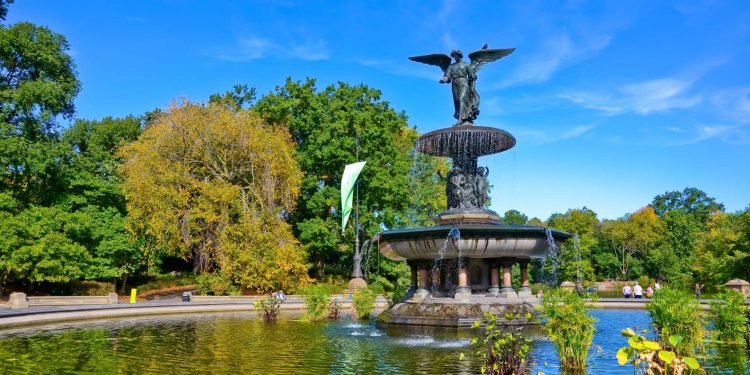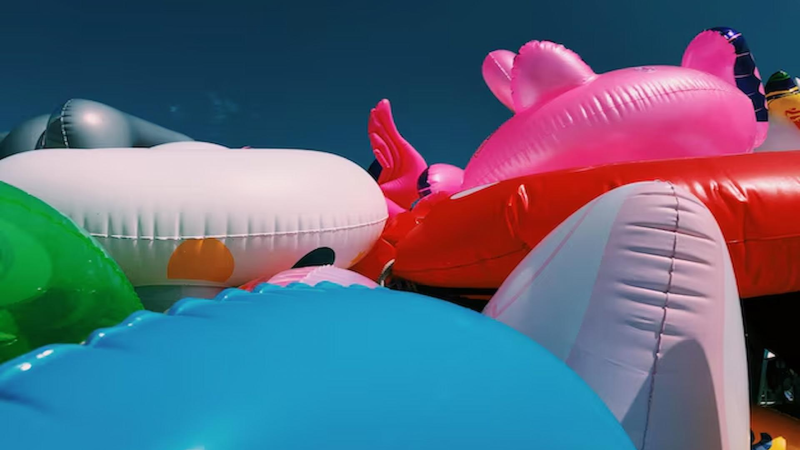: Bethesda Fountain: A Timeless Oasis in the Heart of Central Park

Nestled within the iconic expanse of Central Park in New York City, the Bethesda Fountain stands as a timeless testament to the city’s rich history and cultural heritage. This exquisite monument, with its breathtaking architecture and serene surroundings, has become a cherished oasis for locals and tourists alike. Let’s delve into the history, design, and significance of the Bethesda Fountain, exploring the reasons behind its enduring popularity.
Historical Roots:
The Bethesda Fountain, unveiled in 1873, holds a significant place in the chronicles of New York City. The fountain was designed by Emma Stebbins, making her the first woman to receive a public commission for a major work of art in the city. Stebbins’ creation was part of the larger vision for Central Park conceived by Frederick Law Olmsted and Calvert Vaux, who aimed to transform the urban landscape into a harmonious blend of nature and art.
The fountain’s name, Bethesda, is derived from the biblical pool of Bethesda, known for its healing properties. This choice of name reflects the designers’ intention to create a space where people could find solace, both physically and spiritually, within the heart of the bustling metropolis.
Architectural Marvel:
The Bethesda Fountain is not merely a functional structure but a true architectural marvel. The centerpiece of the monument is the Angel of the Waters, a striking eight-foot bronze statue crafted by Emma Stebbins. The angel stands atop a pedestal adorned with intricate carvings, surrounded by an expansive terrace supported by ornate Corinthian columns.
The entire ensemble is a harmonious blend of classical and Gothic elements, showcasing the Victorian aesthetic prevalent during the time of its construction. The grandeur of the fountain is further enhanced by the surrounding terrace, adorned with ornamental details that invite visitors to marvel at the craftsmanship and attention to detail.
Angel of the Waters:
The focal point of the Bethesda Fountain, the Angel of the Waters, is a symbol of purity and healing. With outstretched wings, the angel gazes serenely downward, holding a lily in one hand and blessing the water with the other. The imagery is evocative of the biblical narrative where an angel bestowed healing powers upon the waters of the pool of Bethesda.
Emma Stebbins’ portrayal of the angel captures a sense of grace and tranquility, making the sculpture not just a piece of art but a source of inspiration for those seeking refuge from the hustle and bustle of urban life. The presence of the angel adds a spiritual dimension to the Bethesda Fountain, elevating it beyond a mere decorative structure to a symbol of hope and renewal.
Cultural Significance:
Over the years, the Bethesda Fountain has played a crucial role in the cultural fabric of New York City. It has served as a backdrop for numerous films, television shows, and music videos, becoming an instantly recognizable icon of Central Park. The fountain’s prominence in popular media has contributed to its status as a must-visit destination for both locals and tourists.
Moreover, the Bethesda Terrace, with its inviting seating areas and panoramic views of the surrounding landscapes, has become a favored spot for artists, musicians, and performers. The vibrant atmosphere created by these artistic expressions adds to the fountain’s allure, turning it into a dynamic space that reflects the diversity and creativity of the city.
A Tranquil Retreat:
Beyond its artistic and historical significance, the Bethesda Fountain offers a tranquil retreat for those seeking respite from the urban clamor. The soothing sounds of the water cascading from the angel’s hands create a calming ambiance, providing a peaceful sanctuary within the heart of Central Park.
The surrounding Bethesda Terrace, with its sweeping views of the lake and the Bow Bridge, offers a perfect vantage point for visitors to immerse themselves in the beauty of nature. Whether it’s a leisurely stroll, a moment of quiet reflection, or a casual gathering with friends, the fountain provides a versatile space that adapts to the varied needs of its visitors.
Conservation Efforts:
Preserving the Bethesda Fountain’s historic charm requires ongoing conservation efforts. The Central Park Conservancy, a non-profit organization dedicated to the maintenance and restoration of Central Park, plays a crucial role in ensuring that this iconic monument remains a jewel in the heart of the city.
Regular maintenance, restoration projects, and community engagement initiatives help safeguard the fountain for future generations. The ongoing commitment to preserving the cultural and historical heritage embodied by the Bethesda Fountain ensures that it continues to captivate and inspire visitors for years to come.
Conclusion:
The Bethesda Fountain stands as a testament to the enduring marriage of art and nature within the urban landscape. Its rich history, awe-inspiring architecture, and cultural significance make it a jewel within the crown of Central Park. As visitors from all walks of life continue to seek solace and inspiration at this iconic monument, the Bethesda Fountain remains a timeless oasis in the heart of New York City, inviting all to experience the beauty and tranquility it has to offer.
Q1: When was the Bethesda Fountain unveiled?
A1: The Bethesda Fountain was unveiled in 1873, making it a historic monument with a significant presence in Central Park’s landscape.
Q2: Who designed the Bethesda Fountain?
A2: The Bethesda Fountain was designed by Emma Stebbins, making her the first woman to receive a public commission for a major work of art in New York City.
Q3: What is the significance of the name “Bethesda”?
A3: The name “Bethesda” is derived from the biblical pool of Bethesda, known for its healing properties. This choice of name reflects the designers’ intention to create a space where people could find solace, both physically and spiritually.
Q4: What is the focal point of the Bethesda Fountain?
A4: The focal point of the Bethesda Fountain is the “Angel of the Waters,” a striking eight-foot bronze statue crafted by Emma Stebbins. The angel stands atop a pedestal and symbolizes purity and healing.
Q5: What architectural style is reflected in the design of the Bethesda Fountain?
A5: The Bethesda Fountain showcases a harmonious blend of classical and Gothic elements, reflecting the Victorian aesthetic prevalent during the time of its construction.
Q6: How has the Bethesda Fountain contributed to popular culture?
A6: The Bethesda Fountain has played a crucial role in popular culture, serving as a backdrop for numerous films, television shows, and music videos. Its iconic status has made it a must-visit destination for both locals and tourists.
Q7: What is the cultural significance of the Bethesda Terrace?
A7: The Bethesda Terrace, with its inviting seating areas and panoramic views, has become a favored spot for artists, musicians, and performers. It adds to the vibrant atmosphere around the fountain, reflecting the diversity and creativity of the city.
Q8: How does the Bethesda Fountain contribute to the tranquility of Central Park?
A8: The soothing sounds of the water cascading from the Angel of the Waters create a calming ambiance, providing a peaceful retreat within the heart of Central Park for those seeking respite from urban life.
Q9: What organization is involved in the conservation of the Bethesda Fountain?
A9: The Central Park Conservancy, a non-profit organization, is dedicated to the maintenance and restoration of Central Park, including efforts to preserve the Bethesda Fountain’s historic charm.
Q10: How can visitors contribute to the preservation of the Bethesda Fountain?
A10: Visitors can contribute to the preservation of the Bethesda Fountain by respecting park guidelines, participating in community engagement initiatives, and supporting the Central Park Conservancy through donations or volunteering efforts.





